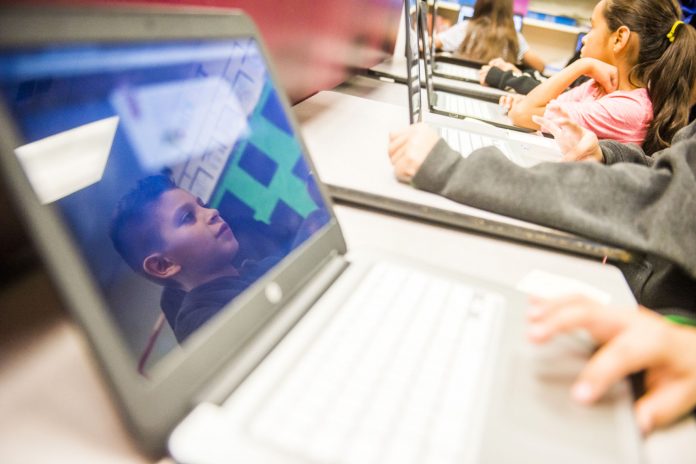
Ladd Lane student Rachel Hartman, 8, and her classmate guided a computerized character through building a house but a stand-in fell into the water two times while making the garden.
The magic of the game—and the reason these two students were playing it in the classroom—is that completing each step required coding. Ladd Lane students in grades K-5 participated in an Hour of Code earlier this month, December 7-13, during computer science education week.
“What’s great about the coding is the kids can’t fail, so they have to solve their problem,” said Assistant Principal Colleen Myers, who helped coordinate the event. “They’re forced to fix the problem so they can move on.”
Teachers set aside an hour that week to let students try the new skill. The decision to participate in the program was not because every student is meant to grow up to be a computer scientist, but because the work helps to sharpen critical thinking skills and encourages soft skills like leadership and teamwork.
The Hour of Code program was organized by the nonprofit, Code.org, supported by companies such as Microsoft, Apple, Amazon and the College Board. Students visited the nonprofit’s website and listened to free, self-guided tutorials that taught them enough coding to play games with “Frozen”, “Star Wars” and “Minecraft” themes.
In the United Kingdom, coding was found to be so important that it became a mandated subject, Myers said.
“The evidence is showing that it’s improving their critical thinking, which is directly going to improve their (test) scores,” the assistant principal said.
Some students, such as Hartman, have been playing with code at home after the subject was introduced in class. The third grader has already coded twice since the topic was brought up, Hartman said.
Fifth grader Brooke Gomes, 10, tried coding before the topic was even introduced in her classroom.
“You could choose what game you wanted to do and then when you click on it, it would give you a video to tell you how to do it,” she explained.
Gomes isn’t planning to be a computer scientist when she grows up, since she already has her eyes set on teaching, but she still liked the activity.
“It was fun,” she said.
Intervention teacher, Jeannine Ostoja, explained that the coding involved a “lot of trial and error,” which was good for students that struggled in other academic areas. The activity also promoted skills that will be important as students grow older, regardless of the profession they choose.
“At Ladd Lane, we exposed our students to code for several reasons,” Ostoja said. “Not because we want them to become computer programmers but because code teaches them how to think critically and how to work collaboratively with their peers.”
Ostoja’s own son is a first grader at Ladd Lane and participated in the program earlier this month. He asked if he could continue at home, she said.
“He’s only 6 and he’s doing it,” she said. “And I’m glad he loved it.”









